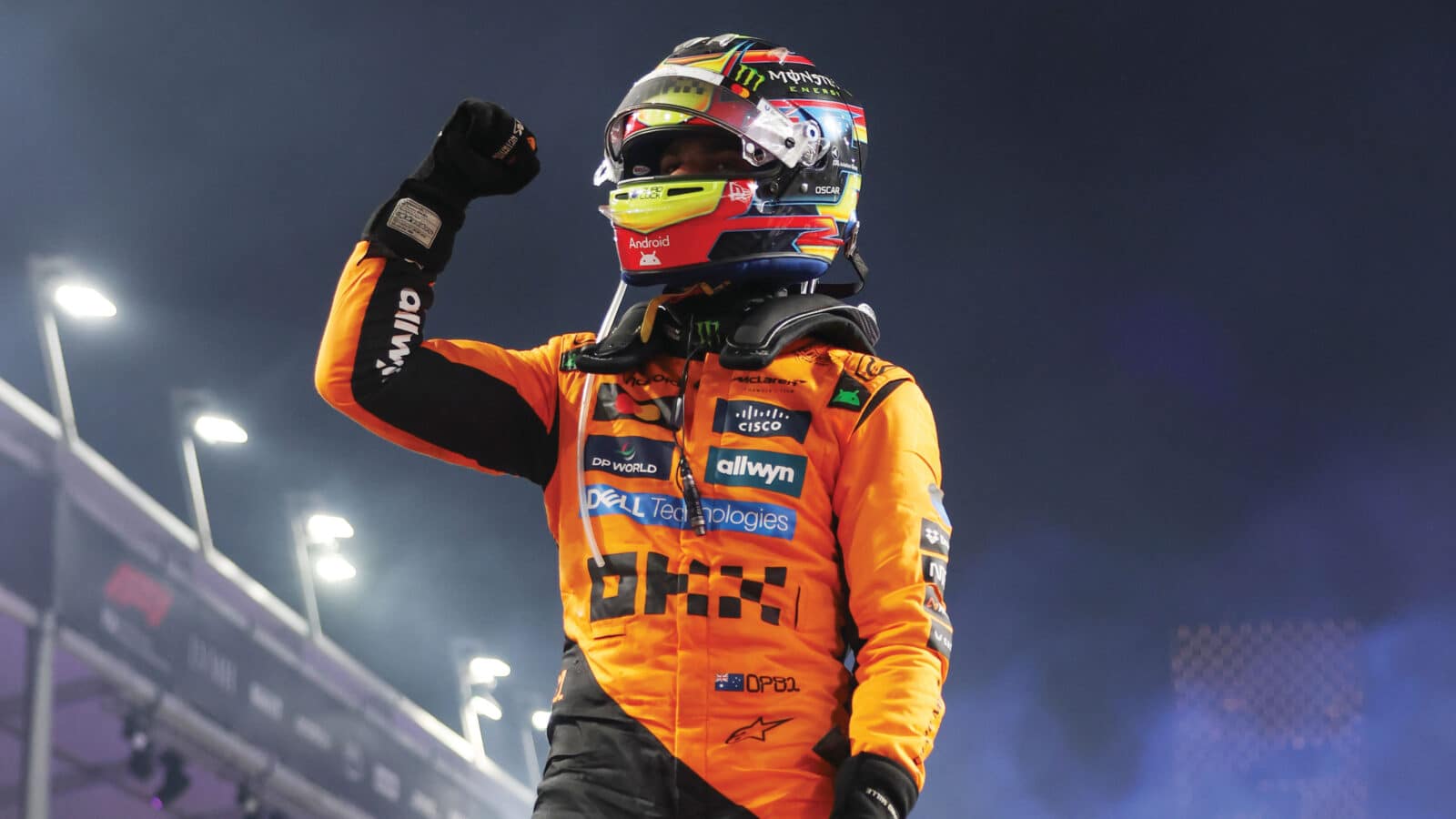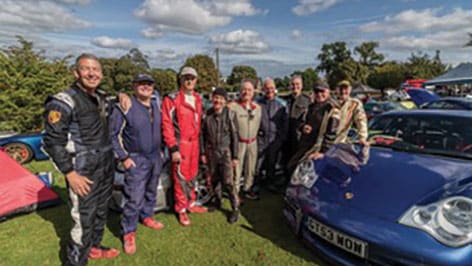Letters: Why Piastri would be a worthy F1 champion
Motor Sport readers toast the success of McLaren’s Oscar Piastri

Oscar Piastri celebrates his win at the Saudi Arabia GP. Is he a champion in waiting?
LAT
Niki Lauda used to say you need to know how to take risks and when to take them. Oscar Piastri’s pass on Lewis Hamilton in Jeddah [Mark Hughes’ Race Report, June] was a pivotal point in the race as he could not afford to spend half a lap or so passing the Ferrari or Max Verstappen would have caught him. It was a risky move but necessary. The kind of move that sets him apart as exceptional and worthy of lifting the drivers’ title this year.
Timothy Hadleigh, Cobham, Surrey
Like many other Australian Formula 1 followers I have been annoyed this year at the British Sky TV (viewed here on Foxtel) commentators blathering endlessly about Lando Norris, Lewis Hamilton and George Russell, feeling that a worldwide broadcast should put aside nationalism and be more open-minded.
But we worry no longer; Oscar Piastri has done it for us, quietly taking the lead in the Formula 1 world championship (as this is written). While they do the talking, Oscar does the winning.
Owen Rye, Boolarra South, Australia

Do miniature wind tunnels take account of the Reynolds Equation? One reader thinks not…
You featured a tiny wind tunnel “so you can test the aero efficiency of your miniatures” [Collectables, May].
Reynolds’ Equation means that as you scale down the size, so you must increase the flow velocity. So that for a 1:18 model of a car that might travel at 100mph, the tiny wind tunnel would need to blow at 1800mph, twice the speed of sound. A smaller model would need the air going even faster.
This toy is just that.
Dr.John Davies, Haverbreaks, Lancaster

Who needs helmet-cams? Spectators get close up to the action during the 1975 Spanish GP
LAT
I smiled to myself on reading the article by Quentin Spurring regarding the proximity and protection afforded during the 1975 Spanish GP [I was walking into the worst day of my racing life, May].
Myself and three friends travelled through the night in July 1962 to Aintree to see the British grand prix, and hopefully my hero, the one and only Jim Clark win the race, which if memory serves, he did.
We were sat on the grass inside the circuit and opposite the race course line of flags, within spitting distance of the track. The proximity to the track was normal in those days, but of course inconceivable today. I’ve reminisced about this trip to younger enthusiasts who find it unbelievable that GPs were run at Aintree.
My letter may jog a memory or two of, like me, “the older” generation of supporters.
Thank you, as always for a very comprehensive magazine, missing only comments on speedway and grasstrack, two of my other sporting loves.
Mike Pocknell, Wimborne
Regarding the Greatest GP Wins [Letters, June]. Has anyone mentioned Jochen Rindt’s incredible finishing laps at Monaco in 1970? Jochen’s very last last lap on the absolute limit, (and unexpected win) is arguably the most memorable from over six decades of my watching GP’s on television.
James Thacker, Tanworth in Arden, Warks
The new-for-2025 Postcard From America section in Matters of Moment is always a fantastic read. Aside from Formula 1, I am a passionate follower of IndyCar and NASCAR and it is great to have it all in one magazine.
Although I was sad to see the Flashback… section come to an end in 2024, the magazine still found a way to be even better than before. Thank you for coving such a range of motor sports with such great insight and presentation.
Leif Moore, Canada

A demon on two wheels, Johnny Cecotto’s brief crack at Formula 1 came crashing down at Brands Hatch – as viewed by our reader
Great to read Mat Oxley’s article on Johnny Cecotto [Motorbikes, May]. It brought back some not very pleasant memories of his Brands Hatch crash in the Formula 1 Toleman.
I was a course marshal at Dingle Dell that day. Johnny hit the Armco just below me on the bank. The car slid down the hill and stopped on the track. I ran down to the car. (There was no waiting for race director permission to enter the track In those days!) Johnny was conscious and trying to lever himself out of the cockpit. I told him to stay still in the car until help from rescue teams arrived, which they did.
I’m so glad he recovered, but sad he never raced again in F1. It was clear to me something had broken, as the car turned sharp left leaving Westfield.
Ian Connell, Cornwall

Reader Peter Herbert and his friends ‘of advancing years’, at the Loton Park Hillclimb
How refreshing for those of us still competing in motor sport in our seventies to read Paul Lawrence’s story The Veterans of Formula Ford in the June edition of your splendid magazine.
Many, mistakenly, see ours as a young man’s sport, missing the point that a lifetime of pleasure can be derived from competitive driving, not only on the track but also through banter in the paddock, friendly rivalry and camaraderie. Indeed, for some, motor sport only becomes affordable in the later years of life.
I have been fortunate enough to have rallied, raced, sprinted and speed hillclimbed for over 50 years. Of course, winning becomes harder, yet other pleasures remain, and just so long as I keep enjoying myself I intend to keep racing, just like those diamond geezers Morris, Kestenbaum and Hardman. Thanks Paul for cheering me up.
Peter Herbert, Moulton, North Yorkshire
Thank you for the beautiful article on the Nivelles-Baulers circuit [Great Lost Circuits] which appeared in the June issue. I’m privileged to have been involved in its history from before the start of the project dreamed up by Mr Yvan Dauriac, who was helped by my father, a member of the RACB’s national sports commission. I also built its promotional scale model.
It is interesting to remember that the initial plan was to use two disused slag heaps in Mons to create a sort of Belgian Laguna Seca but the local socialist mayor feared that the “luxury of motor sports” would “disturb” the local youth. An opportunity presented itself then in the form of a piece of land just north of Nivelles and two investors helped finance the construction of the circuit for £6.5m.
Two things contributed to its end: environmentalists complained about the noise that “landed” in the town of Nivelles because the hillside on which the circuit was built sloped towards the town; and also the Nivelles Commercial Court was concerned about the circuit’s financial situation.
It’s true that the president of this court was the brother of the president of the Circuit de Spa-Francorchamps, who had already tried to have the Zolder circuit closed down because he wanted a non-competition status for his circuit in Belgium!
The example of Britain, France and Germany clearly demonstrates that the number of circuits in a country is a guarantee for the dynamism of the sport and all the companies that make a living from it.
Philippe Casse, Brussels, Belgium
